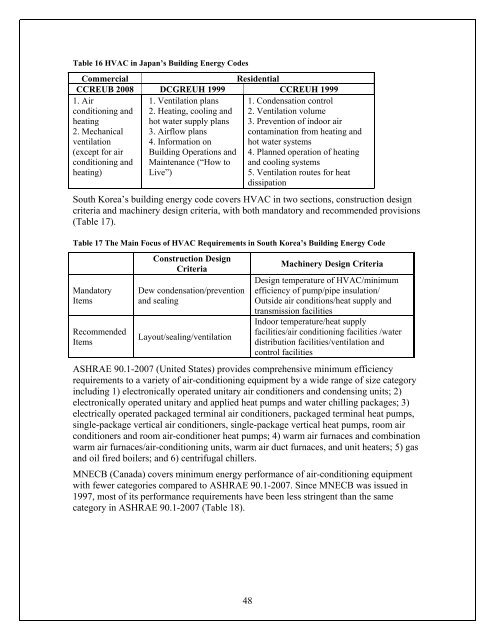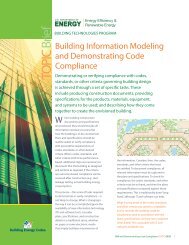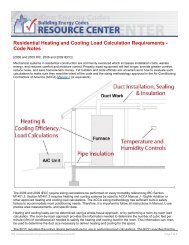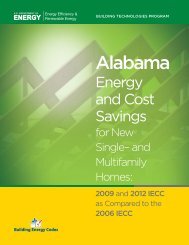Shaping the Energy Efficiency in New Buildings - Building Energy ...
Shaping the Energy Efficiency in New Buildings - Building Energy ...
Shaping the Energy Efficiency in New Buildings - Building Energy ...
Create successful ePaper yourself
Turn your PDF publications into a flip-book with our unique Google optimized e-Paper software.
Table 16 HVAC <strong>in</strong> Japan’s Build<strong>in</strong>g <strong>Energy</strong> CodesCommercialResidentialCCREUB 2008 DCGREUH 1999 CCREUH 19991. Aircondition<strong>in</strong>g andheat<strong>in</strong>g2. Mechanicalventilation1. Ventilation plans2. Heat<strong>in</strong>g, cool<strong>in</strong>g andhot water supply plans3. Airflow plans4. Information on1. Condensation control2. Ventilation volume3. Prevention of <strong>in</strong>door aircontam<strong>in</strong>ation from heat<strong>in</strong>g andhot water systems(except for aircondition<strong>in</strong>g andheat<strong>in</strong>g)Build<strong>in</strong>g Operations andMa<strong>in</strong>tenance (“How toLive”)4. Planned operation of heat<strong>in</strong>gand cool<strong>in</strong>g systems5. Ventilation routes for heatdissipationSouth Korea’s build<strong>in</strong>g energy code covers HVAC <strong>in</strong> two sections, construction designcriteria and mach<strong>in</strong>ery design criteria, with both mandatory and recommended provisions(Table 17).Table 17 The Ma<strong>in</strong> Focus of HVAC Requirements <strong>in</strong> South Korea’s Build<strong>in</strong>g <strong>Energy</strong> CodeMandatoryItemsRecommendedItemsConstruction DesignCriteriaDew condensation/preventionand seal<strong>in</strong>gLayout/seal<strong>in</strong>g/ventilationMach<strong>in</strong>ery Design CriteriaDesign temperature of HVAC/m<strong>in</strong>imumefficiency of pump/pipe <strong>in</strong>sulation/Outside air conditions/heat supply andtransmission facilitiesIndoor temperature/heat supplyfacilities/air condition<strong>in</strong>g facilities /waterdistribution facilities/ventilation andcontrol facilitiesASHRAE 90.1-2007 (United States) provides comprehensive m<strong>in</strong>imum efficiencyrequirements to a variety of air-condition<strong>in</strong>g equipment by a wide range of size category<strong>in</strong>clud<strong>in</strong>g 1) electronically operated unitary air conditioners and condens<strong>in</strong>g units; 2)electronically operated unitary and applied heat pumps and water chill<strong>in</strong>g packages; 3)electrically operated packaged term<strong>in</strong>al air conditioners, packaged term<strong>in</strong>al heat pumps,s<strong>in</strong>gle-package vertical air conditioners, s<strong>in</strong>gle-package vertical heat pumps, room airconditioners and room air-conditioner heat pumps; 4) warm air furnaces and comb<strong>in</strong>ationwarm air furnaces/air-condition<strong>in</strong>g units, warm air duct furnaces, and unit heaters; 5) gasand oil fired boilers; and 6) centrifugal chillers.MNECB (Canada) covers m<strong>in</strong>imum energy performance of air-condition<strong>in</strong>g equipmentwith fewer categories compared to ASHRAE 90.1-2007. S<strong>in</strong>ce MNECB was issued <strong>in</strong>1997, most of its performance requirements have been less str<strong>in</strong>gent than <strong>the</strong> samecategory <strong>in</strong> ASHRAE 90.1-2007 (Table 18).48
















